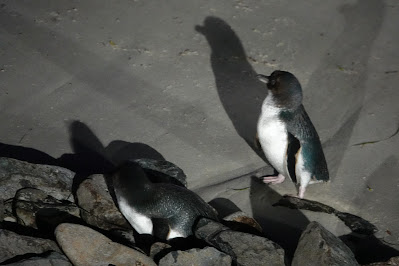You may recall from an early post that we did a kayaking tour with a community organization near Akaroa on the Banks Peninsula south of Christchurch. The group is dedicated to restoring a small, endangered colony of Blue penguins ("Little penguins," "Little blue penguins"), the smallest penguins on earth. It's threatened by the ubiquitous little mammals introduced by the English settlers - possum, cats, weasels - that raid their burrows.
Well, as we've driven around the country since then, we've found many places where Blues can be found; they may be threatened as a species, but their range is wide (which is probably a strength evolutionarily). We were able to observe a healthy colony that lives on the protected grounds of the Royal Albatross Center at the end of the Otago Peninsula near Duniden, on the east coast of the South Island.
The night-time "tour" was fantastic. Because the beach where we would watch the penguins as they came ashore from fishing was a sacred Maori place, our hosts gave us a great presentation on the legacy of Maori sea-faring. Over the span of perhaps 1000 years, Maori in their wakas (wooden canoes) - and with deep knowledge of the stars, weather, ocean currents, and animal behavior - ventured from south Asia to progressively explore and populate most of the South Pacific islands and even east to Rapa Nui, or Easter Island. You can see in the photo, below, the "triangle" of exploration by Maori ancestors, with Hawaii as its northern point; their last "discovery" was Aotearoa/New Zealand.
Back to the Blues. The hour-long oral presentation was designed, in part, for us to wait until the sun set and it was dark enough - darkness is protective cover against predators - for the little birds to head to shore. Small they may be, but their day jobs are massive: they leave their burrows and young-ones before dawn, swim about 10 km to their fishing grounds, cover another 10 km in the hunt, and then swim back 10 km ... whew!
They emerge from the now-dark waters in groups - "rafts" - stand warily on the water's edge watching for threats, then waddle (yes, a group of Blue penguins on shore is called a "waddle") to the base of the cliff or sand dunes where their burrows and hungry charges are. You can watch the process in this video and the photos that follow:
 |
| A "raft" of Blue Penguins emerge from bay and check for dangers |
 |
| The "waddle" reach the base of the hill where their burrows and hungry youth await. |
 |
| Two hungry young penguins bide their time playing together while waiting for their parents to return with dinner |
 |
| Returned parents waiting in line to scale the ridge to their burrows and their hungry kids |
 |
| The "waddle" proceeds from the edge of the sand up the hill |









That’s a lot of swimming birds. Good pictures as always. Doug N.
ReplyDeleteYou got them on a good evening - they're all dressed up.
ReplyDelete-Gary
Omg! I love this story and these photos, and the penquins, of course! amazing. nature is so magical. you are very lucky indeed. thank you for sharing. Marymiller
ReplyDeletesuper cute!
ReplyDelete